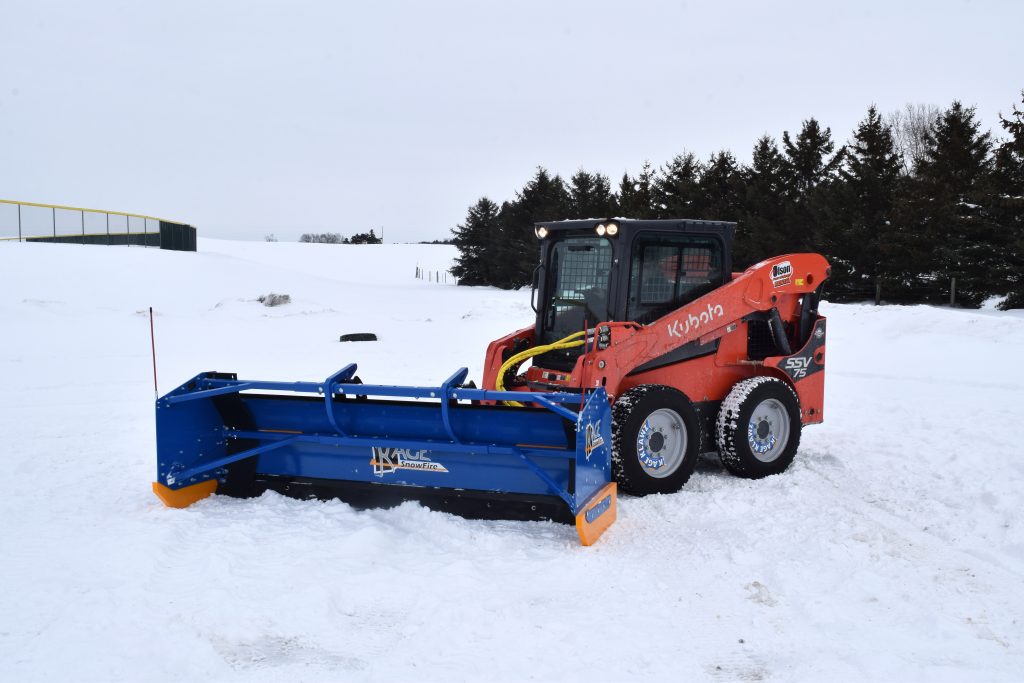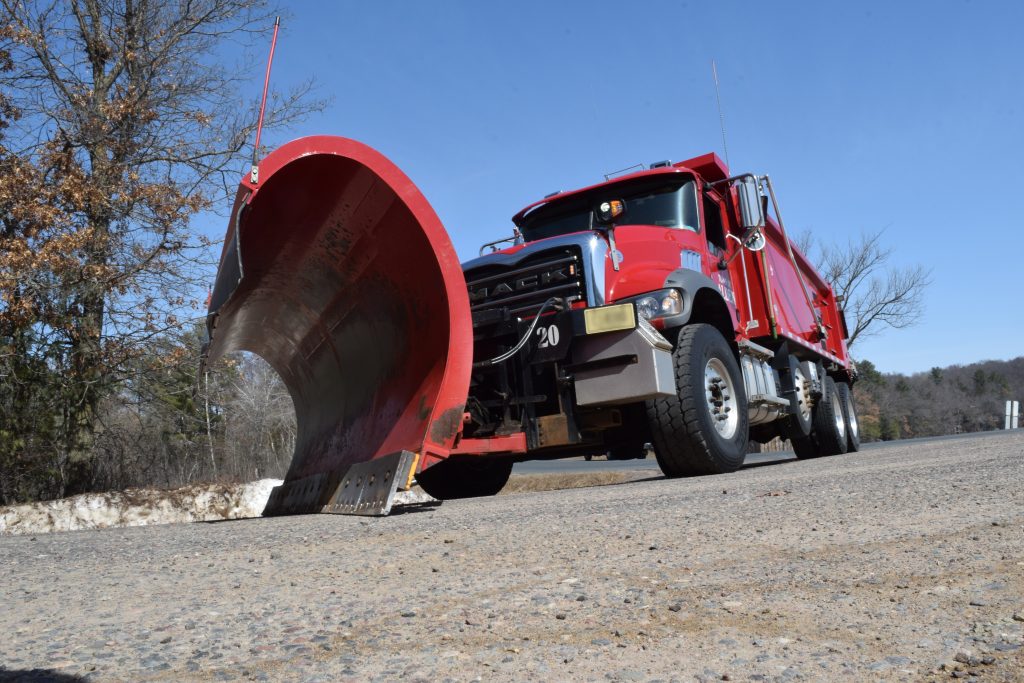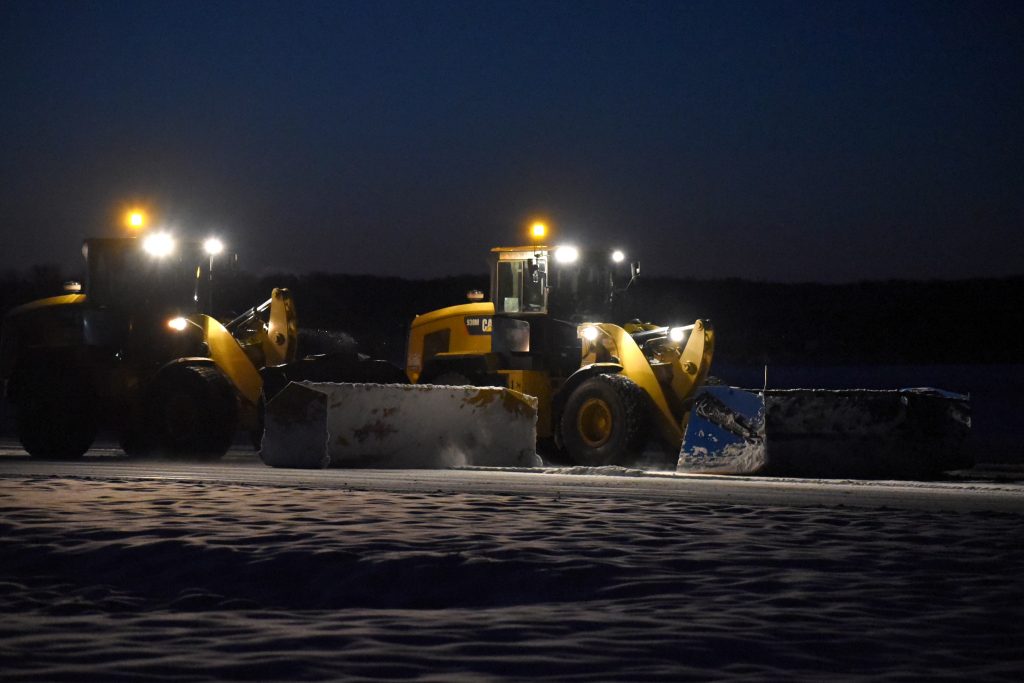When it comes to snow removal, plowing speed is often a critical factor—especially when storms hit hard and fast. But not all snow removal machines operate at the same pace. A combination of horsepower, traction, maneuverability, operator visibility, and attachment type determines how quickly (and efficiently) each machine can clear snow.
Let’s break down how ag tractors, skid steers, compact track loaders, municipal dump trucks, wheel loaders, telehandlers, and tractor loader backhoes compare in plowing speed.
1. Agricultural Tractors
Typical plowing speed: 8–15 mph (13–24 km/h) on open runs
Best suited for: Large, open areas such as rural roads, long driveways, and airport runways
Ag tractors have plenty of horsepower and can be fitted with large front blades, pushers, or rear-mounted snow blades (like the KAGE ShadowBlade) or blowers. Their high road gear ratios let them travel faster than most heavy equipment. On open stretches, a tractor with a wide pusher can plow at highway speeds for extended periods.
However, while they excel in long straight runs, tractors are slower in tight areas due to their long turning radius and slower hydraulic response compared to construction equipment. In icy conditions, their speed may be limited by tire traction unless equipped with chains or specialty snow tires.
2. Skid Steer Loaders
Typical plowing speed: 4–8 mph (6–13 km/h)
Best suited for: Parking lots, sidewalks, and tight, obstacle-heavy spaces
Skid steers are agile and can spin within their own footprint, making them ideal for plowing in confined areas. However, they have lower travel speeds compared to larger machines. Even when equipped with an efficient blade or box pusher, a skid steer will take longer to clear a large lot simply because it can’t cover ground as fast. One way to increase speed it to equip the skid steers with larger diameter snow tires like KAGE Klawz.
That said, their maneuverability and precision mean they often finish complex clearing tasks faster than a faster machine that struggles in tight spots. Speed isn’t everything — efficiency per pass matters too.
3. Compact Track Loaders (CTLs)
Typical plowing speed: 5–9 mph (8–14 km/h)
Best suited for: Mixed-surface areas, sensitive surfaces, and snowy conditions with poor traction
Compact track loaders are similar to skid steers in size and functionality but offer better traction on snow and ice than skid steers without snow tires thanks to their rubber tracks. This can mean slightly higher effective plowing speeds in slick conditions, as they can maintain grip where wheeled machines might slip.
However, tracks are not designed for high-speed travel over long distances, so CTLs still trail behind tractors and trucks for pure speed. They shine in situations where consistent push power is needed more than raw travel velocity.
4. Municipal Dump Trucks with Front Plows
Typical plowing speed: 25–40 mph (40–65 km/h) on roads
Best suited for: Public roads, highways, and long straight stretches
When speed is the goal, nothing beats a well-equipped municipal snow plow truck. These trucks are designed to move at near-traffic speeds while plowing, keeping roads clear without creating a dangerous slowdown. With hydraulic angle plows and sometimes wing plows, they can clear wide swaths in a single pass.
Their limitation? They’re not practical for parking lots or tight spaces. Turning radius, length, and limited visibility in close quarters mean they need to stick to open-road work. In the right setting, though, they are the fastest plowers on this list.
5. Wheel Loaders
Typical plowing speed: 8–12 mph (13–19 km/h)
Best suited for: Large parking lots, airport ramps, and heavy snow piles
Wheel loaders are powerful snow movers with high pushing capacity. While not as fast as dump trucks or tractors, they make up for it with sheer volume per pass. A wheel loader with a massive pusher box or snow basket can clear more snow in one pass than several smaller machines combined.
This means that while their travel speed is moderate, their overall job completion time can be competitive — especially when dealing with deep or wet snow where smaller machines bog down.
6. Telehandlers
Typical plowing speed: 6–10 mph (10–16 km/h)
Best suited for: Multi-purpose use on job sites, snow stacking, and areas requiring extended reach
Telehandlers aren’t typically thought of as snow plowing machines, but with the right attachments they can be effective — especially when it comes to stacking snow high in tight areas. They have decent travel speeds, but their steering and boom design make them less nimble than loaders or skid steers.
Because of their versatility, telehandlers often act as support machines in snow removal operations rather than primary plowers. They can keep up with wheel loaders in moderate-speed applications but can’t match the pushing power.
 7. Tractor Loader Backhoes (TLBs)
7. Tractor Loader Backhoes (TLBs)
Typical plowing speed: 7–12 mph (11–19 km/h)
Best suited for: Medium-sized lots, mixed-material removal, and municipal support work
Backhoes offer good travel speed, moderate pushing power, and the versatility of front and rear implements. A TLB with a snow pusher or plow blade can cover ground faster than a skid steer, but slower than a dedicated ag tractor or truck.
They’re especially useful for towns and contractors who need one machine that can both clear snow and load salt. Their ability to switch tasks quickly makes them valuable for municipal yards and mid-sized commercial properties.
Speed Isn’t the Whole Story
While it’s tempting to look at raw mph as the deciding factor, actual plowing productivity depends on:
-
Blade/pusher width
-
Snow depth and density
-
Operator skill
-
Surface conditions
-
Number of obstacles
For example:
-
A municipal truck at 35 mph might clear 12 feet of road in a pass, but can’t maneuver in a parking lot.
-
A wheel loader at 10 mph might push 20 feet of snow width per pass, clearing a lot in fewer passes despite being slower.
-
A skid steer at 6 mph may technically be slower, but it could finish a small, obstacle-heavy lot faster than any faster-moving machine.
At-a-Glance Comparison Table
| Machine Type | Typical Plowing Speed | Best For | Key Strength |
|---|---|---|---|
| Ag Tractor | 8–15 mph | Long drives, rural roads | High speed + power |
| Skid Steer | 4–8 mph | Tight spaces, parking lots | Maneuverability |
| Compact Track Loader | 5–9 mph | Slippery or uneven areas | Traction |
| Municipal Dump Truck | 25–40 mph | Roads, highways | Speed + width |
| Wheel Loader | 8–12 mph | Large lots, heavy snow | Capacity |
| Telehandler | 6–10 mph | Snow stacking, multi-tasking | Reach versatility |
| Tractor Loader Backhoe | 7–12 mph | Medium lots, municipal | Versatility |
If your goal is maximum snow removal speed over long distances, municipal dump trucks and ag tractors lead the pack. For large parking lots and heavy snow, wheel loaders win with capacity per pass. In tight, obstacle-heavy environments, skid steers and compact track loaders remain unbeatable for precision, even if their top speeds are lower.
In the end, the best snow removal operation often uses a combination of machines, each playing to its strengths—balancing speed, capacity, and maneuverability to keep surfaces safe and clear.
Scenario Setup
Here’s a side-by-side “time to clear” comparison for a 10-acre lot using the seven machine types we discussed.
-
Lot size: 10 acres = 435,600 sq. ft.
-
Snow conditions:
-
Light Snow – ~3 inches, fluffy, easy pushing
-
Moderate Snow – ~6 inches, average density
-
Heavy/Wet Snow – ~12 inches, dense and heavy
-
-
Efficiency factor: Each machine loses time for turns, stacking, and maneuvering. Heavier snow reduces speed by up to 50%.
Estimated Clearing Times
| Machine Type | Typical Working Width | Avg. Working Speed* | Light Snow (3”) | Moderate Snow (6”) | Heavy Snow (12”) |
|---|---|---|---|---|---|
| Ag Tractor | 12 ft | 10 mph | ~50 min | ~1 hr 15 min | ~2 hr |
| Skid Steer | 8 ft | 6 mph | ~1 hr 40 min | ~2 hr 30 min | ~4 hr |
| Compact Track Loader | 8 ft | 6.5 mph | ~1 hr 30 min | ~2 hr 15 min | ~3 hr 45 min |
| Municipal Dump Truck | 12 ft | 25 mph | ~20 min | ~30 min | ~50 min |
| Wheel Loader | 16 ft | 9 mph | ~40 min | ~1 hr | ~1 hr 45 min |
| Telehandler | 12 ft | 7 mph | ~1 hr | ~1 hr 30 min | ~2 hr 30 min |
| Tractor Loader Backhoe | 10 ft | 8 mph | ~1 hr 15 min | ~1 hr 45 min | ~3 hr |
*Working speed is the realistic plowing speed, not the maximum travel speed. It accounts for turning, acceleration/deceleration, and minor backtracking.
Analysis by Snow Condition
Light Snow (~3 inches)
-
Fastest: Municipal Dump Truck — With high working speeds on open lots, trucks blaze through light snow.
-
Runner-up: Ag Tractor — Narrower than a loader but faster than most equipment, especially in long straight runs.
-
Slowest: Skid Steer — Not due to inefficiency, but its smaller width and slower top speed limit total coverage.
Moderate Snow (~6 inches)
-
Fastest: Municipal Dump Truck still leads, though speed drops as blade load increases.
-
Wheel Loader moves up in competitiveness — pushing more snow per pass means fewer trips.
-
Ag Tractors remain strong contenders, especially with wide pushers.
Heavy/Wet Snow (~12 inches)
-
Fastest: Wheel Loader now pulls ahead of trucks for many lot layouts — high traction, massive push capacity, and ability to handle heavy loads without slowing much.
-
Ag Tractors handle it well but need more passes at reduced speed.
-
Skid Steers and CTLs slow significantly because smaller blades fill quickly and require more passes.
Key Takeaways
-
For pure speed: Municipal dump trucks win in light/moderate snow, but wheel loaders dominate in deep/wet snow.
-
For all-around versatility: Ag tractors balance good speed and wide coverage, while still being nimble enough for medium-sized lots.
-
For maneuverability: Skid steers and CTLs excel in tight lots but aren’t competitive for raw speed on open acreage.
-
For multi-role tasks: Tractor loader backhoes and telehandlers aren’t the fastest, but they provide stacking, loading, and plowing capability in one machine.







Recent Comments